Who says you have to propose with a diamond engagement ring?
Of course, it is not hard to imagine a stunning white diamond as the flawless and glittering center stone of your engagement ring.
White diamonds are synonymous with all types of engagement rings and with the engagement ring tradition itself. After all, brides-to-be have been presented with diamonds since 1477 when Archduke Maximillian commissioned the first diamond engagement ring for his beloved Mary of Burgundy.
The Victorians and Edwardians were also fond of ornate engagement rings that combined white diamonds with other gemstones in colorful designs and diamonds have remained hugely popular throughout the centuries – and up to and including the present day.
A diamond engagement ring is still the most popular choice.
The famous “A Diamond is Forever” advertisement from DeBeers was so successful that it has become ingrained in minds and in our culture, and diamonds are still considered the most valuable and appropriate stone to choose for an engagement ring.
But there are diamond alternatives and ring styles, especially if you’re on a budget.
10 Best Diamond Alternatives When Choosing an Engagement Ring
Here are some of our top choices:
Moissanite
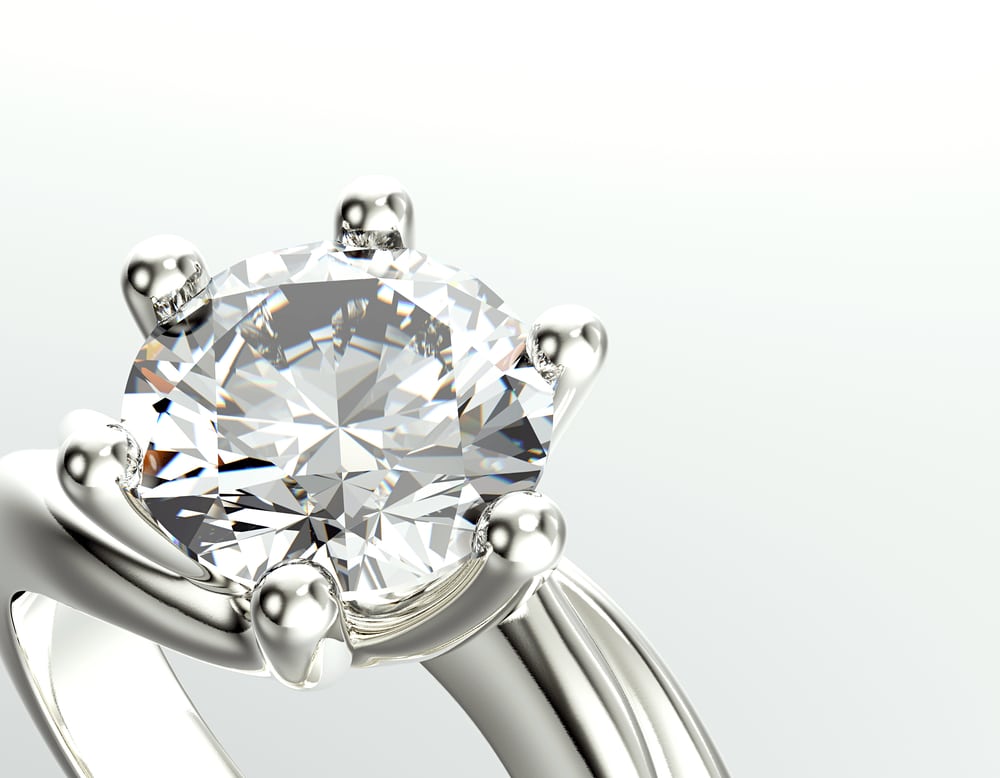
- Mohs Scale Hardness 9.5. (Very durable)
- Cost: 10% or 15% of a diamond’s cost
- Appearance: Sparkling, good fire and typically more brilliance than a diamond
If you like the look of a white diamond, but not the price tag, Moissanite might be a good choice for you. It is a clear-colored stone, though sometimes comes with a slight greenish or yellowish tint.
Moissanite looks very similar to a diamond and is relatively rare. It was discovered by Frenchman Henri Moissan in 1983 in a crater in Arizona and is actually a type of mineral called silicon carbide.
At 9.5 on the Mohs Hardness Scale it is the second hardest mineral in the world, just behind a diamond (which is a 10 on the Mohs Scale), so it is practical, durable and makes a great substitute stone, especially if you are concerned about the stone’s daily care and possible breakage.
Moissanite has great fire and sparkle and typically it has good clarity. A well-cut Moissanite with high quality color, clarity and carat weight can cost 10-15% of a similar quality diamond in terms of its 4C grading so it comes at a fraction of the cost of a white diamond. Its striking resemblance to a diamond makes it difficult to tell one from the other and because it is such a hard stone, the same cuts and designs of diamond rings work equally well.
Moissanite gives you the look, the glamor, the brilliance and the visual prestige of a white diamond – for a lot less money.
These days most of them are grown in a laboratory, so if this detracts from your idea of a romantic engagement ring it may not be the ideal choice for you.
However, if you don’t mind it being artificially made, Moissanite can be the perfect alternative. Moissanite looks lovely in any metal setting – white gold, platinum, yellow or rose gold.
Don’t want to tell your friends and relatives it’s not a diamond? In all likelihood, they will probably not be able to tell the difference.
Morganite
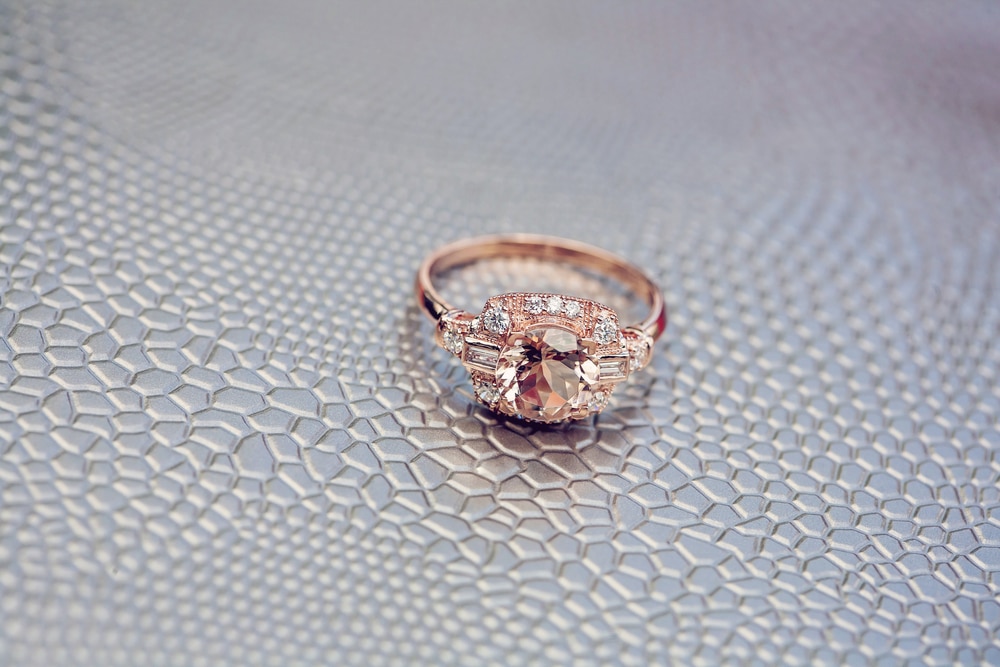
- Mohs Scale Hardness – 7.5. (Softer than diamonds, prone to scratching)
- Cost: Approximately $300 per carat, 10% of a diamond
- Appearance: Soft, blush rose/peach coloration, feminine, romantic looking
Morganite is a semi-precious stone which comes in varying shades of pink, rose, purple and peach. It is the second most popular non-diamond stone after the sapphire and is considered a great alternative to an over- the-top expensive pink diamond, offering its glamorous look for less.
Morganite is a pretty stone belonging to the beryl mineral family which includes emeralds and aquamarine.
The deeper color shades of Morganite tend to be rarer and therefore more expensive, but if you like the ultra-feminine look of a rose or peach colored stone, Morganite is a great choice for the price conscious.
We recommend you choose a rose gold or yellow gold setting to match Morganite’s distinctive pink coloration. A halo of smaller regular diamonds sets off a Morganite center stone to perfection.
Whether you go for a classic Pear, Round, Oval, Cushion, or Emerald cut, or as a solitaire stone, with a halo, on a pavé band, or in a bezel setting, a Morganite engagement ring has a unique look which sets you apart from everyone else’s typical diamond ring.
Morganite is not as durable as diamond, so you will have to be careful with daily care as it can be prone to scratching.
Sapphire
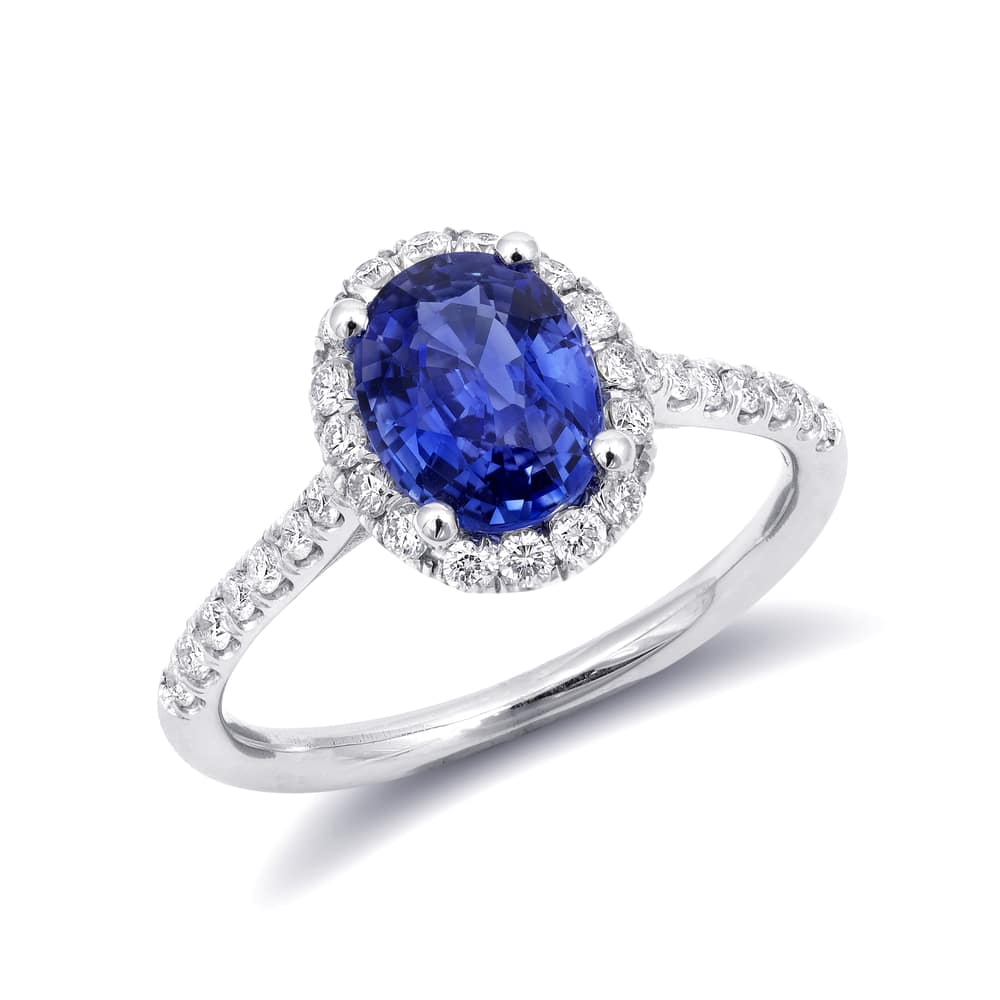
- Mohs Hardness Scale – 9 (Good durability)
- Cost: The best, deeper-colored sapphires are about the same price as a diamond
- Appearance: Royal blue, also available in white, peach, teal and pink
- (Birthstone for September)
The craze for sapphire engagement rings has skyrocketed in recent years.
Kate Middleton and her stunning 12 carat blue Ceylonese sapphire, which was once owned by Princess Diana, caused a huge upswing in sapphire sales. A host of other celebrities have also chosen a sapphire ring to express their love.
While sapphires are most often associated with a distinctive blue color, they are available in many other colors, from white to black. They are considered precious gems and hold their value better than other semi-precious gemstones.
But is it durable? With a Mohs Hardness Scale of 9, the answer is yes.
Sapphires can withstand just about any hard knocks. They don’t break, chip or damage so they are perfect for just about any lifestyle.
Their price is relative to their quality. A top cut, high quality sapphire with a deep color can be as much as a diamond, but if you are willing to compromise in some of the 4Cs, you can get a gorgeous sapphire for less than a white diamond.
Choose a sapphire center stone surrounded by pavé diamonds for an on-trend look that speaks to tradition combined with high style.
Emerald

- Mohs Hardness Scale – 7.5-8 (Fair to good durability)
- Cost: 1 carat goes from $250 to $10,000 depending on quality
- Appearance – 50 shades of green, with inclusions!
Emeralds are a variety of the beryl mineral family and their distinctive green color is due to trace elements of chromium and sometimes vanadium.
Most emeralds have inclusions- or blemishes – so their resistance to breakage is not as good as a diamond’s. They are mostly cut into a special “Emerald” cut, a long, rectangular flat shape with chiseled step cuts and straight linear facets. To add stability and prevent fractures, the corners of the Emerald cut are usually cropped. This cut does not require as much work for the cutter, and thus the emerald is less prone to breakage. Emeralds are also available in Round, Princess, Cushion and Oval cuts so they are quite versatile in terms of style availability.
A combination of a single emerald cut emerald surrounded by two or more smaller diamonds has become a popular alternative to the brilliant round white diamond in recent years because of the growing trend towards colored gemstones. Jackie Kennedy’s engagement ring in the 1950s had a center square shaped emerald surrounded by emerald and diamond accent stones. It is one of the best-known engagement rings in history.
A really fine emerald can be priced higher than a diamond. They are the rarest of all gemstones, rarer than diamonds and can have a price tag to match. Here’s a tip: A 1 carat emerald will have a larger stone than a 1 carat diamond because diamond is a denser stone than emerald, so you can often buy a bigger emerald at a lower price. Blemishes or inclusions in emeralds are a sign of beauty and are what make them unique, hence the clarity 4C does not apply when choosing an emerald.
Ruby

- Mohs Hardness Scale – 9 (Good durability)
- Cost: Depending on color saturation, from $100 up to $18,000 per carat
- Appearance – Varying shades of vibrant red, purplish, deep red with inclusions
- (Birthstone for July)
Roses are red, hearts are red. Considered a precious gemstone, rubies are the color of passion and love and they too have become a popular alternative to the traditional white diamond. If you want a modern look, choose a platinum or white gold setting. For a vintage look, yellow or rose gold sets off the ruby to its best advantage. Rubies are commonly placed with diamonds in engagement rings because diamonds are a symbol of eternity and rubies symbolize love. Placed together their colors and symbolism go hand in hand.
Rubies are formed in unusual conditions from aluminum, oxygen and chromium and as such, they are one of the rarest gemstones on earth. The prized “Pigeon’s Blood” color is rarer still – even at one carat. As you will never find the perfect ruby in terms of color, cut or clarity, you will have to compromise somewhere. The most important characteristic in rubies is the depth of color, so choose a smaller stone with good color – then add side stones or a halo setting to bring out its true beauty.
Aquamarine
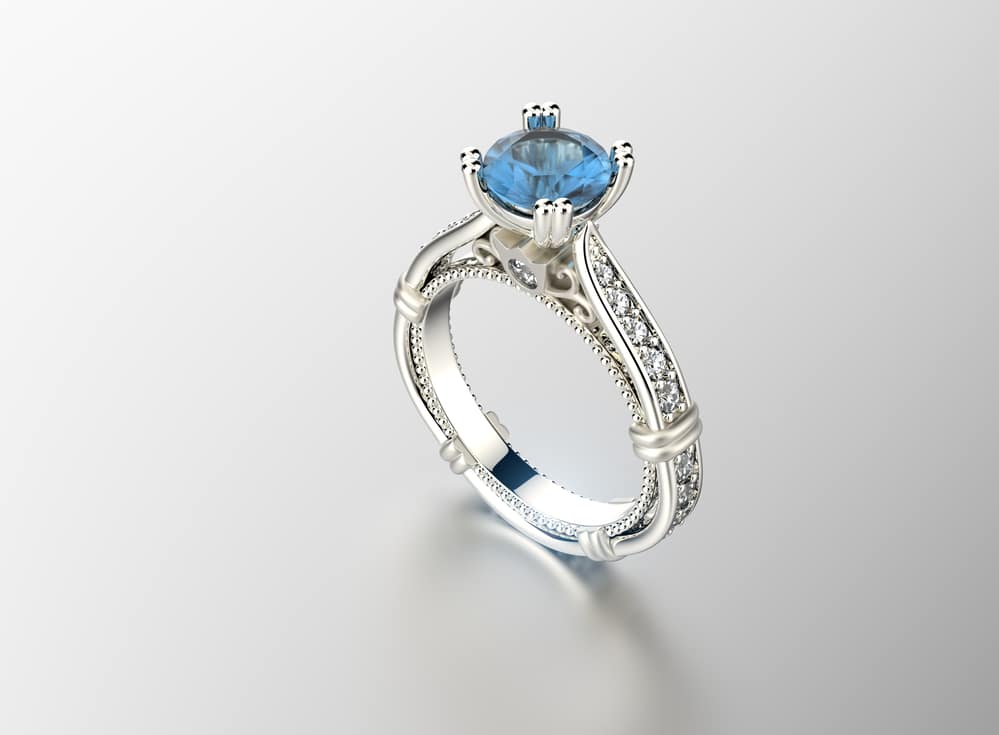
- Mohs Hardness Scale – 7.5 – 8 (Fair durability)
- Cost – $100 – $250 per carat for lighter colored stones, larger stones with deeper coloring $300- $600 per carat.
- Appearance – Blue green to deep blue, delicate coloration
- (Birthstone for March)
The word aquamarine means “Water of the Sea.” One of the most popular semi-precious stones, the aquamarine is a beautiful pale blue stone which belongs to the same family of crystals as the emerald. It has a delicate, almost transparent color and in fact, lighter varieties of aquamarine are often mistaken for diamonds. It is a relatively hardy stone, so it can be worn every day, with appropriate care.
An aquamarine stone looks stunning as a solitaire but equally gorgeous in a halo setting of white diamonds, which brings out its spectacular crystal blue appearance.
Pearl

- Mohs Hardness Scale – 2.5 (Soft)
- Cost: Depending on quality and setting, upwards of $250
- Appearance: Lustrous white, black, gold, cream, pink and many different colors in between
- (Birthstone for June)
Now for something completely different. How about a pearl? Far from your grandmother’s traditional pearl necklace, pearls these days are seen all over the world’s fashion runways and on engagement rings. Pearls are a unique choice for an engagement ring – one that will set you apart. You will get lots of questions and compliments, as you will probably be the only person who has one.
When you think of a pearl you no doubt think of a single round shape but pearls come in a range of shapes sizes and colors, so you can choose a shape that is irregular or combine your pearl with other gemstones or smaller pearls to give you a totally unique looking ring. Your ring designer can get creative, using the color of the pearl and its natural shape to inspire the design. From Black Tahitian pearls to Golden South Sea Pearls, you’ll have a wide selection from which to choose your forever ring.
Pearls are luminous and beautiful, but unfortunately, they do not rank very high on the Mohs Hardness Scale, so they need special everyday handling to avoid scratching and abrading. When word daily without reasonable care, pearls can lose their luster and even chip or break.
Girl with a pearl? Go for it!
Topaz
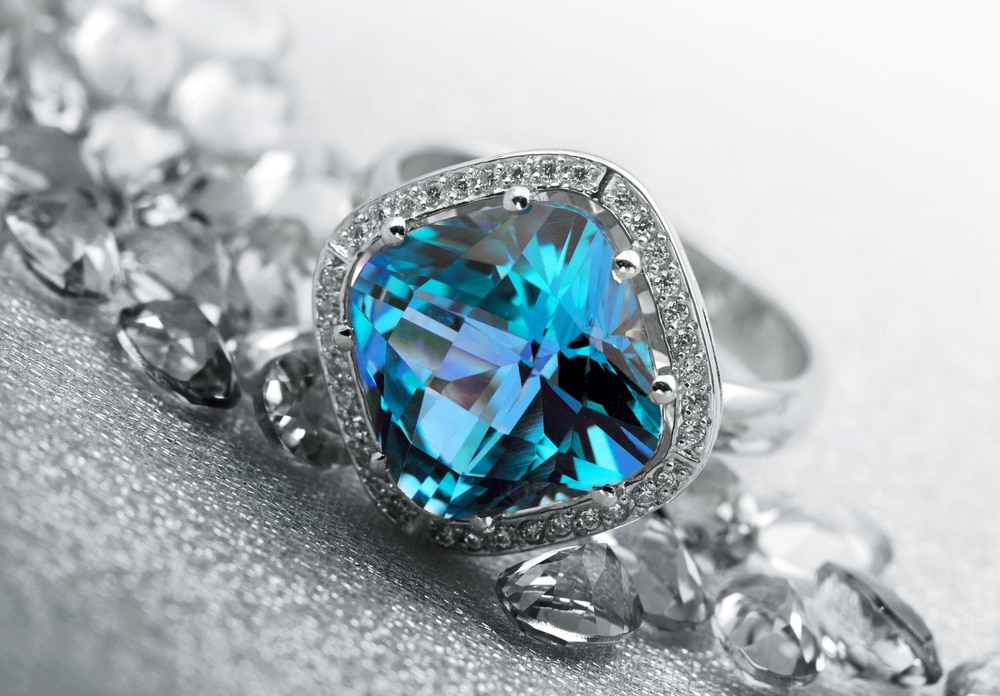
- Mohs Hardness Scale: 8 (Durable)
- Cost: Very good White Topaz is $80 per carat and up
- Appearance – Naturally colorless but heat treated produces browns, yellows, orange, blues and reds
White topaz is often considered a great alternative to a white diamond. Why? It is transparent in its purest form, so it looks very much the same and is much cheaper than a diamond or other alternatives such as emeralds, rubies or sapphires. Topaz has good clarity, albeit with inclusions or blemishes, but it naturally loses its sparkle over time as it will accumulate scratches which dull its surface. In contrast to a diamond, which is more expensive at a heavier carat weight, topaz tends to be cheaper in a larger size because it is likely to have more inclusions. Topaz can be cut in as many shapes as a diamond but is often seen in a round brilliant, long oval or pear.
The most popular color for topaz is blue, which is pretty set with surrounding smaller, colorless stones. Red, pink and orange are the rarest and most expensive topaz colors.
Amethyst
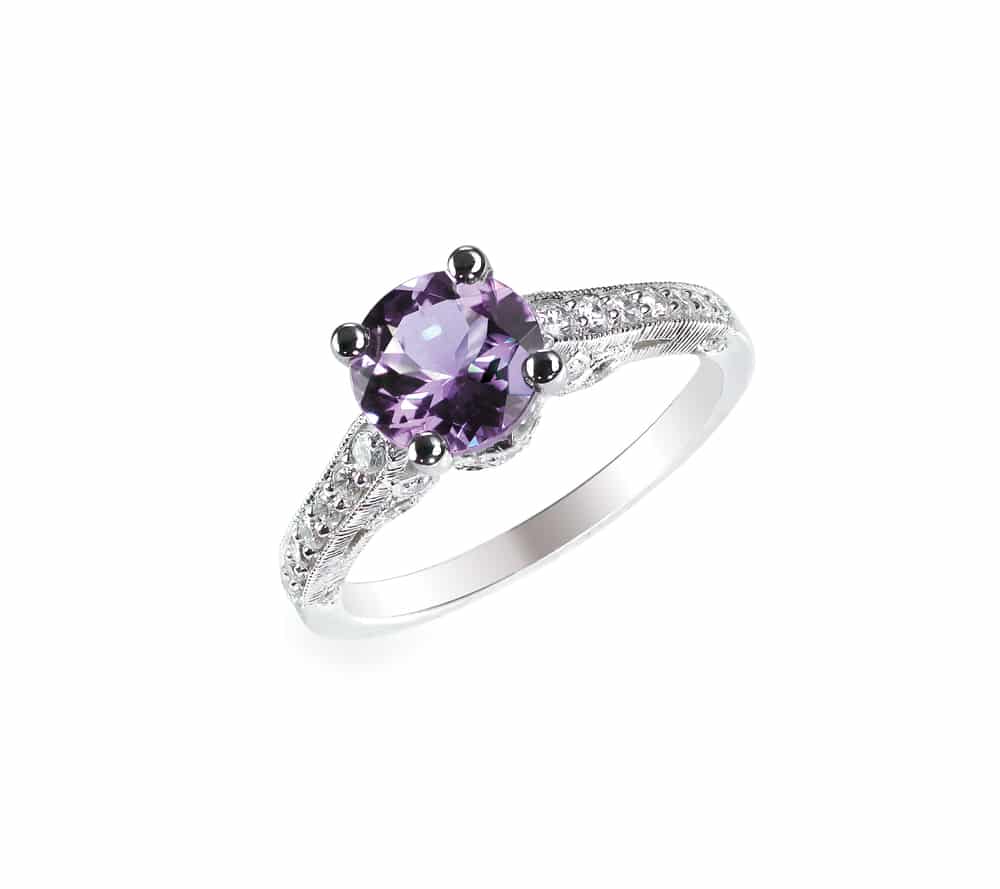
- Mohs Hardness Scale: 7 (Average)
- Cost: $10 per carat (!) For dark purple “Siberian” stones – upwards of $70 per carat
- Appearance: Purple, pinkish, lavender and all shades in between
- (Birthstone for February)
An instant attention grabber because of its vibrant colors, amethyst comes in all shades of purple, lavender and pink. The most valuable color is a deep shade of purple.
Amethysts are available in various cuts and carat weights, so it is easier to customize the design of your ring. It looks particularly good in a Cushion, Oval or even Heart shaped cut in white gold, surrounded by smaller diamonds or other gemstones for a colorful look. Choose a platinum or silver setting to best showcase your amethyst’s beauty.
Opal
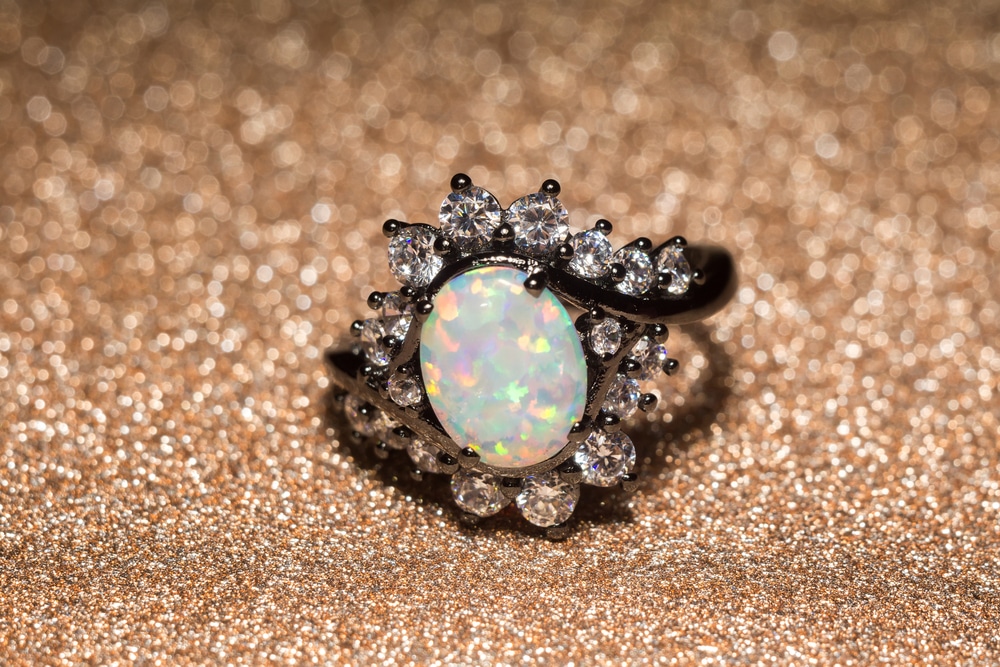
- Mohs Hardness Scale: 5.5-6.5 (Needs extra care)
- Cost: Rare black opals may cost $15,000 a carat, white opals and lighter colors are around $200 per carat and above
- Appearance: Distinctive, wide range of patterns, milky with flashes of red, blue and green, darker colors more expensive
- (Birthstone for October)
Here’s an alternative stone that is as distinctive as it is unusual to find in an engagement ring. If you are looking for something out of the ordinary, an opal engagement ring may be for you.
Opal is an amorphous form of silica which contains from 3% to 21% water within its chemical structure. They form after trapped rainwater evaporates in sedimentary rock layers, leaving behind silica deposits.
Opals come in many different colors; turn them and they emit flashes of extraordinary light and pearlized colors as they move. They shimmer with iridescence and each one is completely individual and different. You can guarantee that no-one else will have the same colored opal as you.
Beautiful they may be, but opals are not as hard as diamonds and they can crack and craze if they get too dry, ending up looking like shattered glass. You need to take extra care if you have an active, sporty lifestyle and not wear your opal 24/7. A claw or bezel setting is best for an opal to make sure it stays secure in the ring. Choose white gold or platinum for a more updated look, surround with smaller gemstones to add more luster. Yellow or rose gold give opals a retro, antique or romantic look.
Whether you choose a traditional white diamond or one of our Top Ten diamond alternatives, make sure you research their particular characteristics, durability, coloration, clarity, cuts and, most importantly, their pricing. You don’t have to buy what everyone else has; there are spectacular, well-priced gemstones available at a fraction of the cost of a typical diamond, so if you are a couple that marches to the beat of your own drum, we’ve given you some great alternatives. You can have a unique ring, tailored made to your specifications for a very reasonable cost.
Your ring choice will hopefully last for many years to come, so it is worth putting in the time to get what you really want – not what everyone else has.
